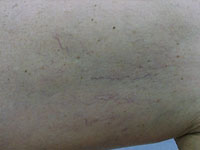Telangiectasia are very common in healthy people. They can appear in different age groups, although older people with aged skin, particularly sun-damaged skin, have a lot more of them. They are more common in women than men, and in fair skinned than darker skinned individuals, probably because of the higher contrast, and the higher frequency of sun damage.
They are basically dilated blood vessels seen through the outer layer of skin. They can be seen anywhere on the body but are more common on the face and legs. When seen on the legs, they are often called spider veins.
They are also more common in some skin diseases, one of them frequently encountered is acne rosacea on the face. Inappropriate long-term use of topical steroid cream on the face is a frequent culprit of these. Several types of inherited disorders also have telangiectasia as a feature. Those in the legs may be related to prolonged back pressure of the vein systems, such as prolonged standing, seating crossed-legged, and after pregnancy.
 |
 |
They appear as red (capillary telangiectasia) or blue (venous telangiectasia), linear or tortuous marks. Red ones have a smaller diameter of less than 0.2mm, while blue ones can be over 1mm. They are usually only a few mm long. When they are numerous enough to become confluent, for example in acne rosecea, the skin appears diffusely red, and discrete individual blood vessels are not seen.
Bleeding from telangiectasia is rare. People usually seek treatment for cosmetic reasons. Simple makeup or fake tan can cover them well. Older methods of treatments include injecting with a super concentrated saline (sclerotherapy), which irritates them so much that they close up, or an electric cautery, which closes up the blood vessels by heat.
While venous telangiectases are quite responsive to sclerotherapy, capillary telangiectases are usually resistant. In fact, it may cause local patches of numerous new capillary telangiectases.
Current preferred treatment method is by laser. The correct wavelengths of some lasers are preferentially absorbed by the haemoglobin contained in the blood cells. This is a kind of selective photo-thermolysis. The heat generated in the process will close the blood vessels.
The lasers used include long-pulse Nd:YAG 1064 nm, long-pulse frequency-doubled Nd:YAG 532 nm, or flashlamp-pumped pulsed dye laser 585 nm. More sophisticated laser machines have a cooling contact during the laser procedure, so as to protect the overlying epidermis from burn. Multiple treatments are usually required. Again capillary telangiectases are more resistant, can persist or return quickly after laser treatment.

